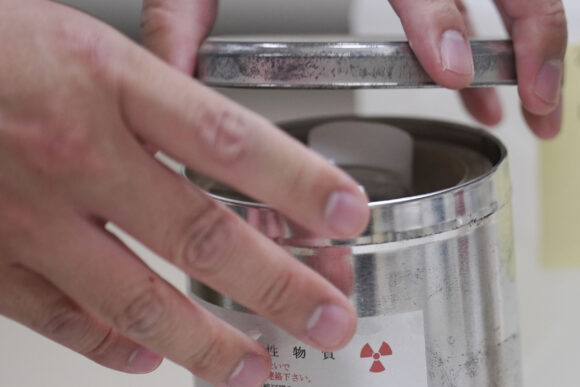TOKYO (AP) — An official in charge of the wrecked Fukushima nuclear power plant says the upcoming release of treated radioactive water into the sea more than 12 years after the reactors` meltdown marks “a milestone,” but is still only an initial step in a daunting decades-long decommissioning process.
Junichi Matsumoto, the corporate officer in charge of treated water management for Tokyo Electric Power Company Holdings, which operates the Fukushima Daiichi plant, also pledged to conduct careful sampling and analysis of the water to make sure its release is safely carried out in accordance with International Atomic Energy Agency standards.
The water is being treated with what`s called an Advanced Liquid Processing System, which can reduce the amounts of more than 60 selected radionuclides to government-set releasable levels, except for tritium, which the government and TEPCO say is safe for humans if consumed in small amounts.
“The release of the ALPS-treated water into the sea is a major milestone for us, as well as for the decommissioning of the plant,” Matsumoto said in an interview with The Associated Press at TEPCO headquarters in Tokyo.
“In order to steadily advance decommissioning, the ever-growing amounts of water was a pressing issue that we could not put off, and we had a sense of crisis,” said Matsumoto, a nuclear engineering expert. “We still have to tackle far more challenging and higher-risk operations such as removal of melted debris and spent fuel” from the damaged reactors, he said.
Another task for TEPCO is combatting the damage to the reputation of Fukushima fisheries caused by the water release, he said.
A massive March 11, 2011, earthquake and tsunami destroyed the Fukushima Daiichi plant’s cooling systems, causing three reactors to melt and contaminating their cooling water, which has since leaked continuously. The water is collected, filtered and stored in around 1,000 tanks, which will reach their capacity in early 2024.
Large amounts of fatally radioactive melted nuclear fuel remain inside the reactors. Robotic probes have provided some information about its status, but it remains largely unknown.
The government and TEPCO say the water must be removed to make room for the plant’s decommissioning, and to prevent accidental leaks from the tanks because much of the water is still contaminated and needs retreatment.
The release plan has faced strong opposition from Japanese fishing organizations, which worry about further damage to the reputation of their seafood as they struggle to recover from the accident. Groups in South Korea and China have also raised concerns, turning it into a political and diplomatic issue.
Matsumoto said the key to gaining understanding is to patiently explain the situation by providing scientific evidence.
“It is difficult, but we hope to make it as easy to understand as possible,” he said. “If we describe (the water release) in one word, it`s safe.”
“As the operator responsible for the accident, we must admit TEPCO is a company that is not fully trusted. We must keep up the effort and sincerely respond to any concern,” Matsumoto said. “It is our responsibility to demonstrate we can carry out the water release as planned, and that’s how we can regain public trust.”
The government said the release is set to start this summer but hasn`t set the date amid protests. TEPCO has obtained safety permits for all of the equipment needed for the release and is currently carrying out training so the water release team can begin work at any time, Matsumoto said.
“It`s not like just turning a faucet to run tap water,” he said.
Scientists generally agree that the environmental impact of the treated wastewater would be negligible, but some call for more attention to dozens of low-dose radionuclides that remain in it, saying data on their long-term effects on the environment and marine life are insufficient and the water requires close scrutiny.
The treated water will be diluted with massive amounts of seawater and will be released gradually over many years.
Matsumoto acknowledged that treated water that came in contact with the damaged nuclear fuel contains radionuclides such as uranium and plutonium that are not in water that is routinely released from healthy nuclear plants around the world.
He said the total concentration of radionuclides in the water meets government standards after treatment, and after dilution the wastewater will be fully safe and have a minimal environmental impact, according to the IAEA, which has provided assistance in evaluating the release plan.
Matsumoto said he has struggled to manage the massive amounts of contaminated water to keep it from escaping into the environment and safely stored at the plant since the accident.
There were instances in which plant workers had no other choice but to dump some into the sea or temporarily put it inside a basement or in temporary water tanks, Matsumoto recalled.
Now, after taking measures to minimize the seeping of rainwater and groundwater into the reactor buildings and establishing a stable water management system, the amount of contaminated water has come down to less than one-fifth of what it used to be, he said.
Top photo: Katsumi Shozugawa, assistant professor at Graduate School of Arts and Sciences of the University of Tokyo, holds a sample of the groundwater containing tritium, cesium and other radionuclides that had been tricked out from the Fukushima Daiichi nuclear plant complex, on Wednesday, July 19, 2023, in Tokyo. (AP Photo/Eugene Hoshiko)
Was this article valuable?
Here are more articles you may enjoy.


 JPMorgan Wins Gender Pay Gap Dispute Against London Analyst
JPMorgan Wins Gender Pay Gap Dispute Against London Analyst  California Governor Seeks $200M to Replace EV Tax Credits Cut by Trump
California Governor Seeks $200M to Replace EV Tax Credits Cut by Trump  Munich Re: Insured Losses From Wildfires, Storms and Floods Hit Record High
Munich Re: Insured Losses From Wildfires, Storms and Floods Hit Record High  Palantir Poaching Suit Called ‘Scare’ Tactic by Ex-Employees
Palantir Poaching Suit Called ‘Scare’ Tactic by Ex-Employees 